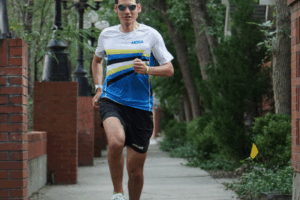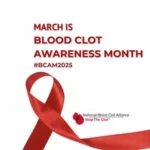FAQs
Frequently Asked Questions about Blood Clots
An Urgent Message from NBCA President Leslie Lake (July 17, 2025)
Did you know that federal funding for blood clot education and public health awareness has been eliminated? I’m personally matching every donation made to NBCA through Sept. 30, 2025, up to $100,000. If you value the work that we do, please consider supporting us with a donation. Now, more than ever, every dollar counts. Learn More
Below you will find answers from our Medical and Scientific Advisory Board (MASAB) to frequently asked questions about a blood clot diagnosis, vitals to monitor, anticoagulants, recovery, exercise, lifestyle changes, genetics, atrial fibrillation, and cancer. Please note that the information on this page is for informational purposes only. No materials on this page are intended to be a substitute for professional medical advice, diagnosis, or treatment. Always consult your doctor if you have any questions regarding your medical condition.
Blood Clot Diagnosis
What is the rate of death in people who have a PE?
What fraction of people with a PE have an identifiable DVT?
What fraction of people with a DVT get a PE?
What is the relationship between a DVT and a PE?
How do I know a DVT isn’t simply a pulled muscle?
Is it common for a Pulmonary Embolism (PE) to be misdiagnosed as a pulled muscle, pleurisy, anxiety, asthma, etc?
Why did I get a chest X-ray?
Is the Ventilation-Perfusion VQ scan the best non-invasive method for detecting a PE?
How is a Pulmonary Embolism diagnosed?
How is a Deep Vein Thrombosis diagnosed?
Vital Questions
What vitals should I monitor when having chest pain?
Should I be checking my own SpO2 after a blood clot?
What is a normal pulse rate?
What are normal SpO2 levels after having a PE?
Anticoagulants
Will this affect my periods? Will anticoagulants make me bleed more?
If I suspect a new clot, should I take anticoagulants until I can seek medical attention?
Are there any natural remedies for blood clots?
Can I replace prescribed anticoagulants with Nattokinase?
How safe are herbal medicines?
Should I wear a medical alert ID bracelet?
What are the signs of “hidden” bleeding?
What is the biggest risk with anticoagulants?
What is home monitoring for warfarin?
What is an INR?
- If a person’s INR is too low, blood clots may not be prevented
- If a person’s INR is too high, they may experience uncontrolled or dangerous bleeding.
While on warfarin, do I need to change my diet? Are there any foods to be careful with?
Why do I feel colder? Is this due to the anticoagulant?
Is it the anticoagulant that is causing my hair to fall out? If so, why is that happening?
Should I take vitamin E supplements while on Coumadin?
What if I need to have surgery while on an anticoagulant?
Is it necessary to be weaned gradually off anticoagulants?
What if I want to stop taking my anticoagulant?
I felt secure when I was taking an anticoagulant, and now feel worried about having another clot, now that I am off my anticoagulant.
What is the most effective way to take medication?
What if I re-clot on the anticoagulant?
Will I need regular blood testing on the anticoagulant you are putting me on?
Will my anticoagulants interact with other medications?
What are reversal agents for anticoagulants?
How do you know if someone will have to be on anticoagulants for life?
How do I know what anticoagulation medication to choose?
- Stop an existing clot from growing
- Preventing the formation of a new clot in other vein segments that could break off and travel to the lungs and become a PE
- Avoiding or minimizing any long-term complications
What are the potential side effects of anticoagulants?
- An unfamiliar headache
- While you will notice bleeding from your GI tract, your nose, and your skin; you may not realize that an unfamiliar headache can be a sign of bleeding in the brain so if you get an unfamiliar or more severe than usual headache you should contact your doctor
- Blood in your urine or stools
- In women, heavy bleeding during a period or excessive vaginal bleeding during the 6-week post-partum period
- Severe bruising
- Prolonged nosebleeds (lasting longer than 10 minutes)
- Coughing up blood
- If you have hemorrhoids, you might bleed a little more
- Learn more about Warfarin or Heparin.
How do anticoagulants work?
Who should know that I am on anticoagulants?
How can I decide which anticoagulant is best for me?
What is the difference between anticoagulants and blood thinners?
Recovery
What are my chances of having another blood clot?
What should my discharge plan look like?
What are the long-term complications of blood clots?
- Post-thrombotic syndrome: persistent swelling, pain, discoloration of the skin in the affected arm or leg; and rarely the skin can break down (ulceration)
- 2-4% of PE patients will have chronic lung damage (thromboembolic pulmonary hypertension)
- Further episodes of clotting
- Anxiety and/or depression
Physical Recovery
What are the warning signs of a new PE?
What are the warning signs of a new DVT?
How does PE affect someone with asthma?
Being short of breath – what is normal and when should I seek urgent care?
Is my leg swelling normal after having a blood clot?
Is a blood clot in the lung absorbed or does it dissolve?
How can I manage lung pain?
What types of over-the-counter pain reliever medications can I take? What is safe to take for pain?
Will I need to get a follow up scan to check the status of the blood clot?
Should I use a heating pad or ice for clot related pain?
Is coughing up blood normal?
How serious is the damage to my body after my blood clot?
What can I expect to feel physically in the next several weeks and months?
- After PE: Shortness of breath and mild pain or pressure in the lungs are common. You are likely to notice pain when you exert yourself, during physical activity, or whenever you take a deep breath. Shortness of breath gets better over time, and exercise helps you use your breath more efficiently. These symptoms should resolve in several weeks.
- After DVT: Post-Thrombotic Syndrome (PTS); persistent swelling, pain, and discoloration of the skin in the affected arm or leg. These symptoms may persist to some degree and are long term in one third to half of cases. Wearing knee high compression stockings for the first 3 months may reduce this risk.




